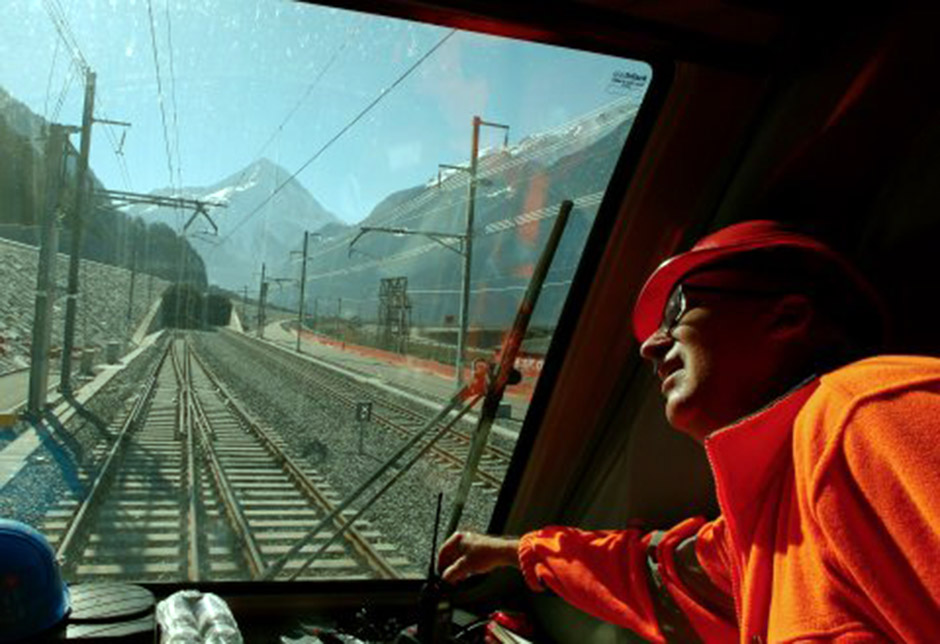[:pb]They may look stunning, but for Europeans, the Alps can be a real pain in the neck. Reaching to just under 16,000 feet, the mountain range forms a thick wall across the continent’s West and center, dividing countries and making much European long-distance travel laborious and slow.
Nowadays, the mountains are of course breached by several major tunnels and highways, a network that has brought hitherto remote valleys within several hours’ journey of major cities. The Alps, nonetheless, still form a speed-slowing barrier between Southern and Northern Europe even today. Starting June 1st, however, that barrier should be considerably less impenetrable.
That’s because next month, Switzerland is opening the longest railway tunnel ever constructed. At a length of 35.5 miles, the new Gotthard Base Tunnelburrows deep beneath the mountains to connect Switzerland’s German- and Italian-speaking regions, ultimately linking the Swiss lowlands with the North Italian plain. It exceeds the length of its longest predecessor, Japan’s Seikan Tunnel, by a little over three kilometers (1.9 miles).
Running at up to 8,000 feet below mountain peaks at times, it also runs deeper below ground level than any other tunnel yet built. So great is the amount of rock and rubble created by the excavation—over 28 million tons—that steep artificial hills have been created in the valleys at the tunnel’s mouth.
While the tunnel’s opening is a triumph, the sheer length of its gestation time shows the degree of commitment—and money—that major infrastructure works require. The tunnel was first approved in 1992 in a national referendum, a product of Switzerland’s system of direct democracy, which sees national votes held on many issues. Work began in 1996, and the actual drilling of the tunnels was only completed in 2011. The total cost to date: roughly $10.3 billion.
The benefits of this huge outlay, however, will be numerous. Now that trains will run on a specially constructed, almost entirely flat track, trains through the tunnel will be able to reach speeds of 150 miles per hour. This will slash the journey time between Zurich and Milan to just two hours and 30 minutes, considerably faster than the current four hours and 40 minutes. While that’s impressive, shorter hops between sub-Alpine cities aren’t really the new tunnels main raison d’etre, and wouldn’t alone necessarily be worth an injection of over $10 billion.
The tunnel’s real role is as part of something much grander, an installment of a massive railway development plan designed to streamline cargo transit across Europe. When complete, this faster network will slash journey times and haulage costs and lure cargo companies off of the continent’s highways and onto the rails. If all goes to plan, this will mean that highways are less congested and the air is markedly less polluted. With less traffic, the death toll on roads should also be reduced.
This matters a lot to the alpine regions, where the limited number of road crossings across the mountains creates bottlenecks that spike pollution and congestion in formerly peaceful, remote spots. But it’s not only in the tunnel’s immediate vicinity where the change should be felt.
The first of these streamlined rail corridors, running through the Gotthard Base Tunnel, will be a line that stretches all the way from Rotterdam in the Netherlands south to Genoa on the Mediterranean Coast. The termini are well-chosen—they essentially form the two furthest points of the mainland section of Europe’s Blue Banana, a heavily urbanized corridor housing more than 110 million inhabitants.

While Genoa is Italy’s busiest port by tonnage, Rotterdam remains the busiest port in Europe bar none. A speedier link to both these ports, where much container traffic from Asia offloads, will make European cargo transit faster, and thus more competitive. It may also have the effect of shifting some cargo destined for Switzerland and Southern Germany south to Genoa, Now that the port has a swifter onward rail connection.
The Gotthard Base Tunnel is still just the longest of the tunnels on several upcoming routes that will radically streamline trans-alpine transit. In Austria, two new tunnels, the Semmering Base Tunnel and the Koralm Tunnel, should be ready by 2024. These will slash journey times between the country’s two main cities, Vienna and Graz, but their main achievement will be to provide a far faster rail corridor ultimately reaching from the Baltic port of Gdansk to Bologna (and thus on to Rome). Meanwhile, in Austria, work has already begun on a major new tunnel under the Brenner Pass that, at 34 miles, will be almost as long as the Gotthard Base Tunnel. Running under the Alps due south of Innsbruck, this will provide a faster route between Italy and the German cities of Munich and Berlin—and possibly on to Scandinavia.
Meanwhile a new East-West alpine link has been given the green light, one that will link Lyon in France with Turin via high-speed rail (a project that has so far proved highly controversial). It should be in service by 2028, ultimately creating a fast rail corridor as far east as Budapest.
All these routes’ alpine sections are of course already served by existing tunnels, many of which were considered great feats in their era. Current infrastructure still often requires trains to undertake slow climbs, or to ring the sides of valleys in order to make a smoother ascent, and isn’t suitable for high-speed trains. This makes journeys along these lines scenically spectacular, but slow. The new tunnels might not be as appealing to tourists (except those in a hurry), but their speed should make the old era of alpine transit seem sclerotic and woefully inefficient.
So far, so good. But while the Gotthard tunnel may point toward a faster, cleaner future for European transit, it’s not quite on the way to realizing its potential just yet. Italy’s rail network still needs major work, and as the worst conditions are in the country’s south, Rome’s current priority may be to work there first. Collaboration between the EU and non-member Switzerland may have unlocked huge amounts of funding and goodwill for continent-shaping projects like the tunnel, but engineers still need to grapple with a clutch of different states, many of whom are facing economic uncertainty. Still, while European rail’s cleaner, faster future may not arrive the day the Gotthard Base Tunnel’s ribbon is cut, at least it’s on its way.
MORE FROM CITYLAB:
Americans Once Blamed Suburbs for Their Illnesses: Best #Cityreads of the Week
Turning Detroit’s Invasive Plants Into Community-Building Art
Finding Humanity in a Burning South Bronx
Nuclear Power Fights for a Spot in Illinois’ Clean Energy Future
Can California Show the U.S. How To Do Elections Right?
Fonte: http://www.businessinsider.com/[:]








